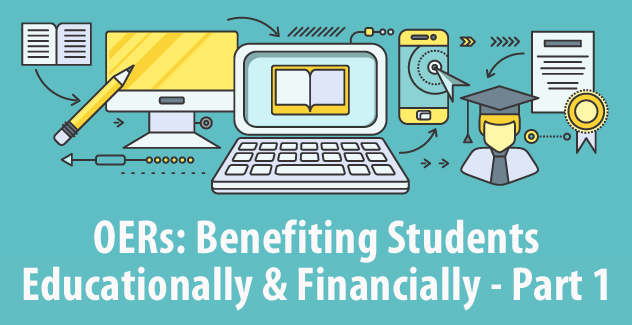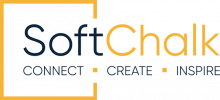
This is the first of two blog posts, written by Lane Gunnels from South Louisiana Community College, discussing how education has evolved over the years and how the responsibility of the teacher has grown. Technology is a big part of both of these and this first post examines how technology is being incorporated into online education and key factors to consider when creating online content so that it is beneficial to both the student and teacher.
OERs: Benefiting Students Educationally and Financially—Part 1
Most educators are able to remember that education must always be focused on the learner, on our students. I will be the first to admit that the bulk of the content in the subjects we teach will not change drastically from year to year. I teach an electrical technology program and even though the National Electrical Code© updates every three years, it does not create the need to drastically change the content in related courses. It is this focus on students that has led me on an incredible journey to lower my students’ attendance costs while improving their learning experience therefore improving their training.
While the information may not change greatly, what does change as time rolls on is how our students are able to receive and process the information that we are providing for them. Long before there were chalkboards, information was given primarily by lecture and probably did not include very many visual or audio aids to help enhance the learning experience. If there were any visual learners sitting at Socrates’ feet, then the struggle may have been very real for them.
Thankfully technology in the classroom has continued to advance since the introduction of overhead projectors and felt boards. Today there are so many tools available to enhance the learning experience that it is actually difficult to keep up with current trends. I have a Promethean Board in my classroom that, when it was installed five years ago, made me a cutting edge instructor for my institution. Now, my position is being eclipsed by the smart boards being used in our newest education building. Don’t fret; I’ve already put in a requisition for the new tech!
Along with technology, is the software that is available to aid us educators in providing learning activities, information sharing, and producing evaluations. The internet makes it almost ridiculously easy to keep our students engaged 24/7. Learning management systems (LMS) can integrate so easily with an ever increasing variety of software and application. This enables nearly an unlimited frontier for the creative educator or instructional designer to produce very effective courses. We are able to design courses that can deliver content in previously undreamed fashion. I will explore some of the ways I accomplished this in my next blog. Of course, none of this comes without a price. OER (Open Educational Resources) may be increasing across the board, but most institutions are still required to use materials designed by for-profit education companies. Unfortunately this cost is usually passed on to our students, especially in higher education. With tuition and fees increasing steadily, I am concerned for my students that are coming from a disadvantaged background. As a CTE instructor, I get quite a few of these students each year.
I was not sure of what options were available to me that would help my students with the cost of attendance. I began to hear about OER and did some preliminary research to see who was providing anything that I could use in the program. I didn’t find anything that I felt was suitable to deliver my content that could and would impact my students beneficially. It was a bit of a disappointment, if I can be truthful here.
As part of my professional development, I took a course for online instructor training through the parent system of my institution. I was exposed to SoftChalk for the first time. I had a conversation with my facilitator during the course and explained to her what I was trying to do with my program and she touted the benefits of SoftChalk Create. The facilitator thought it was just the tool I needed in order to bring my students a little further along into the 21st Century.
My requisition for my first subscription was approved. I quickly wrote five lessons for the upcoming subject and explained to my students what I was attempting and why. They were all for being part of the experiment. Once they had completed the lessons, they told me how much better they were than the chapters they had been reading out of the required textbooks. They appreciated how the lessons got to the point, the written examples were brief, yet still detailed, and they truly enjoyed some of the interaction in lessons such as the Hot Spot activity.
I knew immediately I had made the right choice in using SoftChalk and that the next step towards the future of the program had been taken. I proceeded to create lessons at a furious pace and had two entire courses worth of content ready to go for the new semester. As we began preparing for the upcoming academic year and a fresh cohort for my program, I took a bold step and informed the college bookstore that I would not need any of the previously required textbooks for my program.
I am including a link to one of those first five lessons I wrote. I believe it provides a clear picture of how easy SoftChalk made it to remove the textbooks from my curriculum. Click below:
Lesson: NEC© Requirements for Solar PV Systems
I am now entering my fourth year using SoftChalk. As a result I have also not required the purchase of textbooks for the program, therefore also saving my students money. The impact has been more widespread than I could have possibly imagined.
In my next blog I will share the results that this has had on my students, me, and the program.
 Lane Gunnels is currently the Lead Instructor for the Electrical Technology Program for South Louisiana Community College. He has been teaching higher education for ten years and believes in using innovative methods to deliver content. He is fond of saying, “Just because the message may not change doesn’t mean the delivery method cannot change.” A U.S. Navy veteran, Lane took his military electrical training and experience into the classroom and has proceeded to re-design and modernize an electrician program. He has been the recipient of the SLCC “Faculty Excellence in Teaching” award and is also the first CTE instructor for SLCC to be elected the Faculty Senate President. As well as being the first 2-year term president, Lane is the first president to be elected from a campus outside of the main SLCC campus. His dedication to his students, demonstrated by his efforts towards innovation, has helped him earn these accolades.
Lane Gunnels is currently the Lead Instructor for the Electrical Technology Program for South Louisiana Community College. He has been teaching higher education for ten years and believes in using innovative methods to deliver content. He is fond of saying, “Just because the message may not change doesn’t mean the delivery method cannot change.” A U.S. Navy veteran, Lane took his military electrical training and experience into the classroom and has proceeded to re-design and modernize an electrician program. He has been the recipient of the SLCC “Faculty Excellence in Teaching” award and is also the first CTE instructor for SLCC to be elected the Faculty Senate President. As well as being the first 2-year term president, Lane is the first president to be elected from a campus outside of the main SLCC campus. His dedication to his students, demonstrated by his efforts towards innovation, has helped him earn these accolades.
Lane has been using SoftChalk for several years and freely admits that he would not be as successful as a classroom innovator if it were not for the features and accessibility of SoftChalk.

Leave a Reply